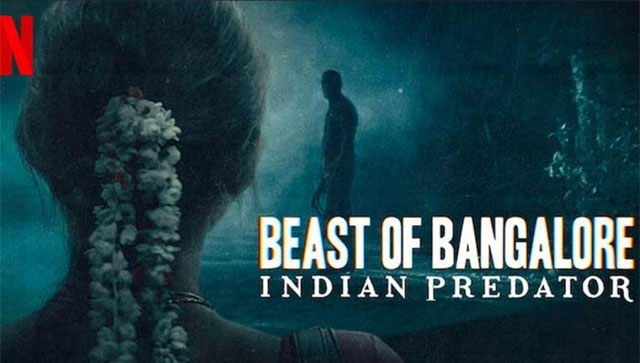In a sequence from latest instalment of Indian Predator titled The Beast of Bangalore, a police officer tries to illustrate an accused’s second escape from police custody. As we hear the officer narrate a rather straightforward escape made tricky by a fractured foot, we are shown a recreated version of the incident with the focus solely on the subject’s feet. It’s a sequence that highlights the series’ naivety and creative imprudence. For an instalment that harks back to cases 25 years ago, The Beast of Bangalore, struggles to both, import the cultural moment and the specificity of its importance in a series that has now resorted to doing little other than press the thumb of recollection on the head of memory. This latest tepid outing serves a reminder that in the absence of raw footage or visual allies, some stories, despite the tools of music and recreation, are better told in writing. The Beast of Bangalore tells the story, the swift confession and the modest mystery surrounding cop-turned-serial killer Umesh Reddy. Born in Chitradurga, a district located some 200 kilometres outside Bangalore, Reddy, a former police servant, exacted brutal violence on several women across state lines. His most immediate victims, however, were women of his home state of Karnataka. Lonesome, widows or single, Reddy cunningly targeted the weak and the socially disabled. It makes Reddy a servile schemer whose lechery wasn’t just unforgiving but also methodical. He was caught on a couple of occasions, but with time he also mastered the art of escaping from underneath the police’s nose. None of these are really spoilers, which makes you wonder what a series might want to do with the material. The 3-episode series begins with the crimes, without really acknowledging the victims at length, and quickly moves onto the discovery of Reddy, his aliases, his history of crimes and the many minor twists and turns before he was eventually captured in Bangalore. All that sounds fine, possibly discomforting and intriguing at the same time, but The Beast of Bangalore simply fails to capture the gruesome of the crime or the perpetuity of a demonic man’s stinging worldview. We hear from a number of officers and experts, but other than the odd paper clipping or a photograph, there are far too few points of entry into a story that ought to have first set its canvas. Good documentaries can often be persuasive despite the absence of visual assistance but here there is really no twist, except that a Wikipedia-ish article plays out with disinterested quotes from the people who, to an extent, co-wrote it. This feels like nostalgia, a narrative set up without jeopardy, gleefully unfurling like a straightforward walkthrough of a life set in crime. Furthermore, there is hardly anything that familiarises us with Reddy to the extent that we either recognise him as an idea or as a living, breathing human being. What is the point really of doing this other than entrust the goriness of the details to themselves elevate this story to some sort of emotional rooting? At 3 episodes long, Indian Predator understandably wants to race through material, hopping onto a new landscape to paint a comprehensively grim picture of the Indian landscape, but in doing so, it has also evidently started to struggle to differentiate one from the other. There is mention of Bangalore’s evolution during the 90s, some allusion to the arrival of big tech, but none of it actually contributes to setting up the milieu of a story that in the absence of suspense, must eventually become about the humanity of the victims and lack thereof of the ones who perpetrate such crimes. Instead, the series is content with waltzing past details with a handful of first-hand accounts that merely nudge the show forward rather than add anything revelatory or of substance. At some point you even wonder if these stories are better told through fiction, where creative liberties might allow for tighter narratives intended to accomplish more than the bare minimum. Cinematic touches galore, Indian Predator is now beginning to look like a clever associative project aimed at widening the map rather than finding something worthwhile to say on it. At this point it accomplishes something fairly well compared to a Wikipedia entry and criminally little compared to a long-form piece written with the poetic desire to not just show, but tell with a certain tone, rhythm and context in sight. But then either Indian Predator is spoilt for choice, or merely trying to serve a demographic. Not necessarily by telling stories of violence and crime with some sort of nuance, but by lighting a routinely larger bulb over the head of a smaller one.
Manik Sharma writes on art and culture, cinema, books, and everything in between. Read all the Latest News , Trending News , Cricket News , Bollywood News , India News and Entertainment News here. Follow us on Facebook , Twitter and Instagram .
)